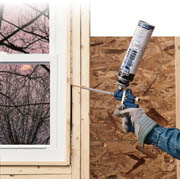
In order to maintain the warranties, contractors had to use other means to offer insulating and energy efficient properties. One option was to chink fiberglass into crevices around windows; however, once the strands of glass are compressed and broken during this packing process, the fiberglass no longer provides an appreciable amount of insulation. Chinked fiberglass also allows for moisture to flow into the cavities, which can lead to even larger problems such as mold, mildew and rot.
Low pressure is on
Now, this is all changing. Warning stickers on windows are becoming a thing of the past thanks to the new technologies in the polyurethane foam industry. New, high-tech one-component polyurethane foams have been reengineered to offer enough expansion to fill gaps around windows and doors while creating considerably less pressure.The perception in the past has been that expansion causes window and door failures. The reality is the high pressure of common polyurethane foams, not the expansion, is the main cause for window and door failures were polyurethane foams have been used. These new technology, low-pressure polyurethane foams form superior air seals that in turn prevent heat loss and noticeable drafts.
Polyurethane foams offer an excellent means to weatherproof a window or doorjamb when used in conjunction with typical flashing material used on the outside surface of the window opening. The foam is dispensed as a liquid, not a froth, allowing it to more readily flow into gaps and crevices. Polyurethane foams adhere tenaciously to most building materials except for Teflon, polyethylene, silicone, oils and greases and similar surfaces. These foams can be used when installing wood, vinyl- or metal-clad windows.
One-component polyurethane foams cure slowly to a semi-rigid material and will not shrink, crack or pull away when fully cured, which takes approximately 12 to 24 hours, depending on ambient conditions. Foam is generally cuttable after one hour.
Way of the gun
These new window and door polyurethane foams are available as either straw foams or gun foams. Straw foams are preferred by one-time users. For professional contractors who will use the polyurethane foams repeatedly, gun foams are often preferred. Gun foams require the purchase of a professional dispensing unit or gun. These guns are lightweight and easily metered allowing more control of the dispensed bead of foam. Whether using a straw foam or gun foam, the installer need only fill the void approximately half full to allow the foam to expand and cure.Another important consideration when selecting polyurethane foam for window and door applications is whether the foam is an open-cell or closed-cell product. Open-cell products are comprised of many tiny cells, which have expanded to the point that they burst which can allow for moisture to migrate. Closed-cell foams offer a contiguous cell structure, thus creating a more watertight finished product.
Window installers and homeowners alike will appreciate the benefits provided by window and door polyurethane foams. Installers will be drawn to the product for its ease of use and less labor-intensive application. Homeowners will be thankful for the positive effects of reducing energy bills while creating a more comfortable living environment. Window and door polyurethane foams offer a win-win situation.

Report Abusive Comment